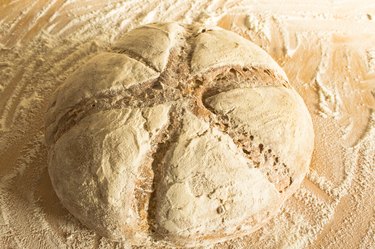
Milling wheat for flour is a laborious process, but it produces flours of varying gluten content. Gluten has recoil and stretch properties, giving structure to your finished goods. The difference between using bread flour and high gluten flour will determine if you end up with a flaky croissant or a roll that gives your jaw a workout. Adding liquids, sugar, eggs, and leaveners to flour is a matter of science as is the temperature of your kitchen and your oven.
Protein Content
Video of the Day
Bread flour is made from hard wheat -- either hard red spring wheat or hard red winter wheat. High-gluten flour is typically made from hard red spring wheat. Hard wheat grown in cold climates, such as the wheat used to make high-gluten or high-protein flour, is higher in protein than hard winter wheat used for bread flour. Bread flour is 11.5 to 13.5 percent protein while high-gluten flour is 13.5 percent to 14.5 percent protein. As the protein content or the quality of the protein in flour increases, the capacity of the flour to form gluten also increases, according to Shirley Corriher, author of the book "BakeWise, The Hows and Whys of Successful Baking."
Video of the Day
Gluten
Gluten, a structure molecule, is a composite protein that forms when the proteins glutenin and gliadin are mixed with water and agitated, leavened and fermented. Glutenin enables your dough to recoil, or come back to shape after it has been kneaded and pulled. Gliadin enhances the capacity of your dough to be stretched. Bread flour is best for croissants, sweet yeast dough and soft rolls. High-gluten flour is better for bagels, hard rolls and thin crust pizzas, breads that require the highest degree of strength and structure.
Potassium Bromate
Potassium bromate is a food additive often added to high-gluten flours, increasing the strength of the gluten. This means the dough may be stretched more without breaking. Potassium bromate has been shown to cause cancer in rats, according to the California Office of Environmental Health Hazard Assessment. Read the label of your flour or ask your baker if potassium bromate is used as this substance has not been banned in the United States. Instead, the FDA has merely encouraged bakers to stop using it, according to a fact sheet by King Arthur Flour.
Starch Granules
Starch is another structure building molecule in flour. Starch absorbs water. Starch granules are damaged during the milling process. Damaged starch granules absorb even more water. High-gluten flour has more broken starch granules than bread flour. Dough made with high-gluten flour need a greater amount of water compared to dough using bread flour.